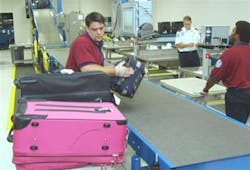New Baggage System Frees up Vital Minutes in Atlanta
Checking in your baggage at Hartsfield-Jackson International Airport is getting easier, thanks to a new screening system.
The high-tech system takes passengers back to the pre-Sept. 11 days, when customers simply checked bags with airline officials while getting a boarding pass.
How much time can you expect to save?
"Six or seven minutes," said Willie Williams, the federal security chief at the airport.
For the past two years, passengers have had to check in, then carry their bags to huge screening machines and hand them over to security officers.
The officers hefted the bags into the screening machines and hand-searched them, if necessary, before sending them along to the airlines.
The workers and machines took up precious floor space at the world's busiest airport and were "horrible for customer service," said Ben DeCosta, the airport's general manager.
"Now you just put it on the belt and it's gone," he said.
Janet Powell, who was on her way to Britain on Thursday, said, "I think it's a very good idea, because I am not standing in longer lines."
Randy Neice, from Michigan, was traveling through Hartsfield-Jackson for the first time Thursday.
"I'm all for safety," he said. "I think it would be easier for sure and a lot more efficient."
And anyone who's running late for a flight certainly understands how precious a few minutes can be.
"Timeliness is of the essence," Neice said.
The airport began phasing in the new baggage screening system on July 6.
The system is already fully operational in the North Terminal --- where AirTran operates --- and partially operational in the South Terminal, where Delta is.
The entire $170 million system, which included road reconstruction costs, should be up and running in less than two months.
Because the new baggage screening system is more efficient, some security officers will be reassigned to entry-point screening, DeCosta said. Passengers won't see the five miles of conveyors, high-tech X-ray and CT scan machines, lineups of computers and underground rooms that are replacing the old system.
The system can handle more than 8,600 bags an hour, which is more than enough for the 1 million checked bags that pass on average through the airport in a given month, DeCosta said.
From the airport lobby, bags slide into a maze of blue conveyors that conduct them to a lineup of scanning machines. The machines X-ray the whole bag, and if unidentifiable or suspicious items are noted, it uses CT scan technology to more closely examine them.
Officers in a separate room view each suspicious bag on a lineup of monitors. They can tell the conveyor system to send a bag on to the airline or to a room where officers hand-search bags.
The system benefits the officers as well. "It eliminates a lot of lifting and back injuries," said Joe Matthews, an officer still manning one of the old stations in the lobby Thursday.
Christopher White, a Transportation Security Administration spokesman, said the new setup, with all the hand-searching going on in one room, is expected to cut down on claims of losses out of hand-searched luggage as well.
Levertes Ragland contributed to this article.
Copyright 2005 LexisNexis, a division of Reed Elsevier Inc. All rights reserved.
Terms and Conditions | Privacy Policy
News stories provided by third parties are not edited by "Site Publication" staff. For suggestions and comments, please click the Contact link at the bottom of this page.

